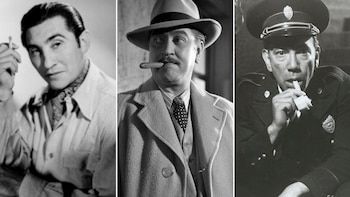
Rodolfo Acosta, Carlos Moctezuma, Víctor Parra and Miguel Inclán were some of the actors who established themselves as the best villains in cinema during the Golden Age, but among them there was one that was most coveted due to his talent in playing antagonistic roles.
Victor Parra
Victor Parra was one of the first artists to be called a villain, since since 1946 he was required by directors to be the protagonist who would make life difficult for the characters in the films in which he participated. Although his career was not long, it was full of successes linked to the good performance of hostile roles.
His first film as antagonistic was Champion Without a Crown (1946), a film in which villainous actor Carlos Moctezuma also participated. From then on, he devoted himself mainly to playing antagonistic characters, participating in more than 40 films and winning the Ariel Award three times.
His first Ariel was for Best Male Coacting in El muchacho alegre (1949), then in Ángeles del arrabal (1950) also for Best Male Coacting and the third for Best Actor in Los Fernández de Peralvillo (1955).
Rudolph Acosta
Rodolfo Acosta was one of the great Mexican villains, consolidating himself as such in 1948 with his portrayal of a pimp in Salon Mexico. Although he acted in at least 20 films, only for Salón México he was nominated for Ariel for Best Male Coacting.
The Port of the Seven Vices, Sensuality and The Sea and You were some of the films where he stood out before trying his luck in Hollywood. From 1953 onwards, Acosta continued his career in the United States and only returned in 1965 to perform in Rio Hondo.
Miguel Inclan
In 1943 Miguel Inclán played one of the most hated characters of the time, Don Damián in María Candelaria. Although his career began several years earlier, it was from this film that he consolidated himself as a villain and, in addition, rose to international fame.
Then, in 1948, he again became Mexico's most important antagonist with Us the Poor. Despite his great success as a villain, he wanted to break out of his own mold and ventured into characters that weren't bad. It was in Salón México that he played the protagonist opposite the one played by Rodolfo Acosta.
Although Inclán worked in María Candelaria, Nosotros los pobres, Salón México and Los Olvidados, films that are currently cult, he never managed to be nominated for any awards, nor did he get any recognition for his legacy.
Carlos Moctezuma
Carlos Moctezuma was also one of the first actors to become a villain during the golden years of Mexican cinema. His first starring role as a character that inspired mistrust was with The Millions of Chamfer in 1938, since then his career rose to the point of participating in nearly 200 films.
In most of the films in which he acted, he played the roles of thugs, as he was typecast in that type of character. However, he also played the role of good-natured, just as he was in Champion Without a Crown and Our Father.
He received the Ariel Award in the Best Actor category for Rio Escondido (1947) and Best Male Coacting for his participation in El Rebozo de Soledad (1952) and in Como México no dos (1979).
Thanks to his extensive career, his much applauded talent and legacy, he is the one who is mostly recognized as the most important villain of the Golden Age.
KEEP READING:
Últimas Noticias
Debanhi Escobar: they secured the motel where she was found lifeless in a cistern

The oldest person in the world died at the age of 119

Macabre find in CDMX: they left a body bagged and tied in a taxi
The eagles of America will face Manchester City in a duel of legends. Here are the details

Why is it good to bring dogs out to know the world when they are puppies



